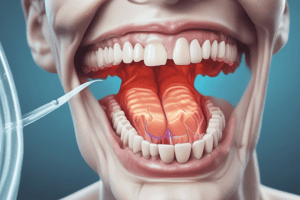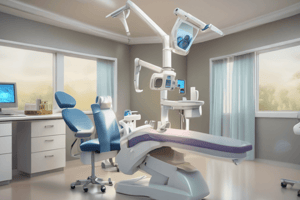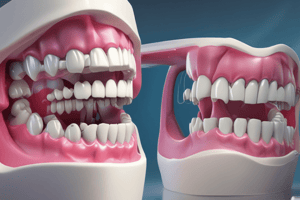Podcast
Questions and Answers
Enucleation is a treatment option for nasoalveolar cysts.
Enucleation is a treatment option for nasoalveolar cysts.
True (A)
Nasoalveolar cysts are visible on radiographs.
Nasoalveolar cysts are visible on radiographs.
False (B)
Nasoalveolar cysts are characterized by a rapid growth rate.
Nasoalveolar cysts are characterized by a rapid growth rate.
False (B)
Nasoalveolar cysts are typically painful and cause discomfort.
Nasoalveolar cysts are typically painful and cause discomfort.
Nasoalveolar cysts are a type of odontogenic cyst.
Nasoalveolar cysts are a type of odontogenic cyst.
Nasoalveolar cysts are more common in the lower lip.
Nasoalveolar cysts are more common in the lower lip.
Surgical removal with thorough curettage of the bone is a recommended treatment option for Keratocystic Odontogenic Tumor.
Surgical removal with thorough curettage of the bone is a recommended treatment option for Keratocystic Odontogenic Tumor.
Keratocystic Odontogenic Tumor is always symptomatic and causes significant discomfort.
Keratocystic Odontogenic Tumor is always symptomatic and causes significant discomfort.
The histomorphologic feature of Keratocystic Odontogenic Tumor includes a thick, non-cellular lining.
The histomorphologic feature of Keratocystic Odontogenic Tumor includes a thick, non-cellular lining.
The radiographic feature of Keratocystic Odontogenic Tumor includes a diffuse, ill-defined radiolucent lesion.
The radiographic feature of Keratocystic Odontogenic Tumor includes a diffuse, ill-defined radiolucent lesion.
Keratocystic Odontogenic Tumor is associated with a non-vital tooth in the area.
Keratocystic Odontogenic Tumor is associated with a non-vital tooth in the area.
Keratocystic Odontogenic Tumor is more commonly found in the maxilla than the mandible.
Keratocystic Odontogenic Tumor is more commonly found in the maxilla than the mandible.
The treatment for odontogenic keratocyst involves only enucleation without peripheral ostectomy.
The treatment for odontogenic keratocyst involves only enucleation without peripheral ostectomy.
Histologically, odontogenic keratocysts are characterized by a thick wall with masses of keratin in the lumen.
Histologically, odontogenic keratocysts are characterized by a thick wall with masses of keratin in the lumen.
Lateral periodontal cysts arise from the periodontal ligament of an impacted tooth.
Lateral periodontal cysts arise from the periodontal ligament of an impacted tooth.
Radiographically, odontogenic keratocysts often appear as a unilocular radiolucency.
Radiographically, odontogenic keratocysts often appear as a unilocular radiolucency.
Lateral periodontal cysts are of known etiology.
Lateral periodontal cysts are of known etiology.
Odontogenic keratocysts are more common in the maxilla than in the mandible.
Odontogenic keratocysts are more common in the maxilla than in the mandible.
Flashcards are hidden until you start studying





